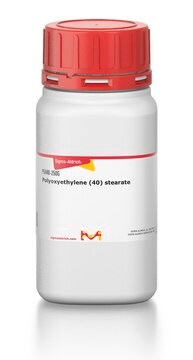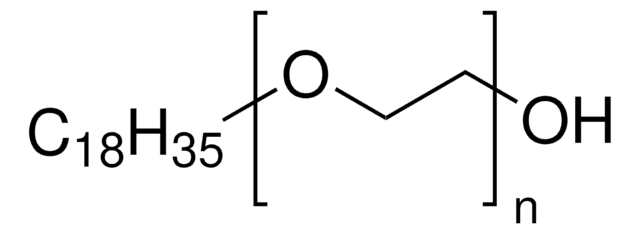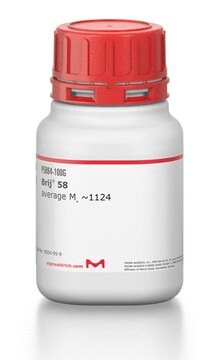466387
Brij® S 100
average Mn ~4,670
Synonyme(s) :
Polyoxyethylene (100) stearyl ether
About This Item
Produits recommandés
Poids mol.
average Mn ~4,670
Niveau de qualité
Pf
51-54 °C (lit.)
Indice d'hydroxyle
13‑25 mg KOH/g
Solubilité
propylene glycol and xylene: insoluble
Densité
1.1 g/mL at 25 °C (lit.)
HLB
18
InChI
1S/C20H41O2/c1-2-3-4-5-6-7-8-9-10-11-12-13-14-15-16-17-19-22-20-18-21/h2-20H2,1H3
Clé InChI
PSEGVHKUPXNGGJ-UHFFFAOYSA-N
Vous recherchez des produits similaires ? Visite Guide de comparaison des produits
Catégories apparentées
Application
- as a non-ionic surfactant to study its interactions with luminol electrochemiluminescence for bioanalysis
- as a carrier material to study the formulation of nimodipine, fenofibrate, and o-vanillin using the particles from gas-saturated solution (PGSS) process
- as a hydrophilic surfactant in the casting solution to prepare an asymmetric flat sheet nanofiltration membranes and to study its effects on the hydrophilic property of the poly(ethersulfone) (PES) nanofiltration membranes
Informations légales
Mention d'avertissement
Warning
Mentions de danger
Conseils de prudence
Classification des risques
Acute Tox. 4 Oral
Code de la classe de stockage
11 - Combustible Solids
Classe de danger pour l'eau (WGK)
WGK 2
Point d'éclair (°F)
Not applicable
Point d'éclair (°C)
Not applicable
Équipement de protection individuelle
Eyeshields, Gloves, type N95 (US)
Faites votre choix parmi les versions les plus récentes :
Déjà en possession de ce produit ?
Retrouvez la documentation relative aux produits que vous avez récemment achetés dans la Bibliothèque de documents.
Les clients ont également consulté
Notre équipe de scientifiques dispose d'une expérience dans tous les secteurs de la recherche, notamment en sciences de la vie, science des matériaux, synthèse chimique, chromatographie, analyse et dans de nombreux autres domaines..
Contacter notre Service technique









